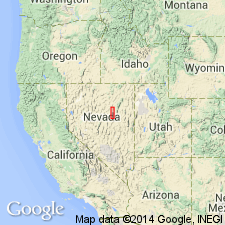
- Usage in publication:
-
- Telegraph Canyon member
- Modifications:
-
- Named
- Dominant lithology:
-
- Dolomite
- Limestone
- AAPG geologic province:
-
- Great Basin province
Summary:
Named for exposures along both sides of Telegraph Canyon [40 deg 05' 52"N, 116 deg 01' 33"W] in central Mineral Hill 15' quad, Eureka Co, NV. Type section in Telegraph Canyon. Is upper member of three of Nevada formation in Sulphur Springs-Pinyon Ranges area. At base composed of alternating light and dark gray mottled and finely laminated dolomite. In Old Whalen section limestone tongue is thin-bedded and poorly bedded blue-gray fossiliferous limestone with small amounts of gray thin-bedded dolomite and local nodular chert. Is 2000 ft thick at type. Complete exposed member at Williams Canyon is 1950 ft thick, thins to 800 ft in northern Pinyon Range. Overlies Union Mountain member (new) of Nevada formation; underlies Devils Gate Limestone. Upper beds contain Cladopora fauna ("spaghetti" texture). Tongue contains Martinia kirki fauna. Is similar in texture and sedimentary structures to Simonson dolomite (Osmond, 1956). Correlated with upper three members of Middle Devonian age of Nevada formation in Eureka district.
Source: GNU records (USGS DDS-6; Menlo GNULEX).
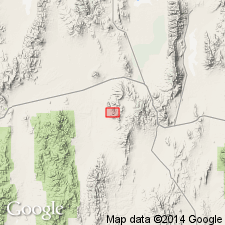
- Usage in publication:
-
- Telegraph Canyon Formation
- Modifications:
-
- Areal extent
- Biostratigraphic dating
- AAPG geologic province:
-
- Great Basin province
Summary:
Nevada Group with McColley Canyon Formation and Telegraph Canyon Formation recognized in Table Mountain, Mahogany Hills area. Here Telegraph Canyon is approx 2255 ft thick. Underlies Devils Gate Limestone; overlies McColley Canyon Formation. Age is Middle Devonian based on crinoid and Stringocephalus fauna.
Source: GNU records (USGS DDS-6; Menlo GNULEX).
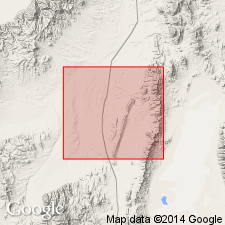
- Usage in publication:
-
- Telegraph Canyon Formation
- Modifications:
-
- Revised
- AAPG geologic province:
-
- Great Basin province
Summary:
Nevada Formation of Carlisle and others (1957) in Sulphur Springs and Pinyon Ranges area raised in rank to Nevada Group. Members raised in rank to Union Mountain and Telegraph Canyon Formation, [McColley Canyon Formation, previously raised to formation rank by Johnson (1962)].
Source: GNU records (USGS DDS-6; Menlo GNULEX).
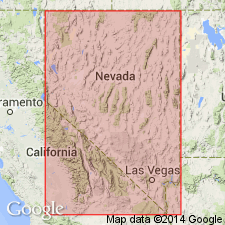
- Usage in publication:
-
- Telegraph Canyon Formation
- Modifications:
-
- Revised
- AAPG geologic province:
-
- Great Basin province
Summary:
In Sulphur Spring Range area divided into upper Telegraph Canyon and lower Telegraph Canyon members which interfinger with Woodpecker tongue [previously called limestone tongue of Telegraph Canyon member by Carlisle and others (1957) and Woodpecker Limestone? by Johnson (1971)].
Source: GNU records (USGS DDS-6; Menlo GNULEX).
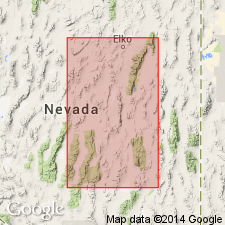
- Usage in publication:
-
- Telegraph Canyon Member
- Modifications:
-
- Revised
- AAPG geologic province:
-
- Great Basin province
Summary:
Telegraph Canyon Member of Carlisle and others (1957) replaced by Sentinel Mountain Dolomite in Sulphur Spring Range.
Source: GNU records (USGS DDS-6; Menlo GNULEX).
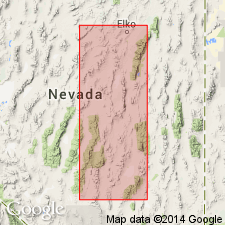
- Usage in publication:
-
- Telegraph Canyon Formation†
- Modifications:
-
- Abandoned
- AAPG geologic province:
-
- Great Basin province
Summary:
"Our model requires only the minimum number of names for rock units." Rejected name Telegraph Canyon Formation of Carlisle and others (1957). "Upper and lower members" [see Johnson and Sandberg, 1977] called Bay State Dolomite and Sentinel Mountain Dolomite respectively of Nolan and others (1956), "as a matter of priority". [Johnson (1968) previously recognized Telegraph Canyon Formation in Table Mountain-Mahogany Hills area. Kendall and others (1983) replaced Telegraph Canyon Member in Sulphur Spring Range with Sentinel Mountain Dolomite.]
Source: GNU records (USGS DDS-6; Menlo GNULEX).
For more information, please contact Nancy Stamm, Geologic Names Committee Secretary.
Asterisk (*) indicates published by U.S. Geological Survey authors.
"No current usage" (†) implies that a name has been abandoned or has fallen into disuse. Former usage and, if known, replacement name given in parentheses ( ).
Slash (/) indicates name conflicts with nomenclatural guidelines (CSN, 1933; ACSN, 1961, 1970; NACSN, 1983, 2005, 2021). May be explained within brackets ([ ]).

